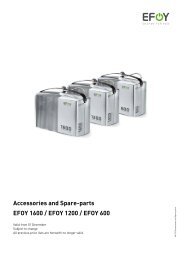NEW - Cooltech Leisure
NEW - Cooltech Leisure
NEW - Cooltech Leisure
Create successful ePaper yourself
Turn your PDF publications into a flip-book with our unique Google optimized e-Paper software.
All technical data, see P. 112 – 113 or www.my-caravanning.com<br />
99<br />
Minimal power requirements for some electrical appliances<br />
Device Power rating Quality of the output voltage<br />
Coffee maker (filter) 800 – 1500 watts modified sine wave voltage<br />
Coffee maker (pads) 1200 – 1600 watts pure sine wave voltage<br />
Espresso machine 1200 – 1600 watts pure sine wave voltage<br />
Microwave oven 1000 – 1600 watts pure sine wave voltage<br />
Toaster 1000 – 1500 watts modified sine wave voltage<br />
Kettle 1000 – 1500 watts modified sine wave voltage<br />
Reading lamp 50 – 100 watts modified sine wave voltage<br />
Energy-saving bulb 10 – 20 watts pure sine wave voltage<br />
Fluorescent tubes 50 – 100 watts pure sine wave voltage<br />
Example:<br />
≥ Largest appliance on board is a<br />
toaster with 1400 watts<br />
≥ The technically most demanding appliance is<br />
an electric toothbrush with 50 watt output<br />
Our recommendation:<br />
A sine wave inverter with at least 1400 watts:<br />
WAECO SinePower MSI 1812(T)<br />
Alternatively:<br />
WAECO PerfectPower PP 2002 for the<br />
toaster and an additional sine wave inverter<br />
SinePower MSI 212 for the toothbrush<br />
Audio/video device 100 – 200 watts pure sine wave voltage<br />
Laptop computer 100 – 200 watts pure sine wave voltage<br />
Power drill/circular saw 500 – 1500 watts modified sine wave voltage<br />
Vacuum cleaner 1000 – 1600 watts modified sine wave voltage<br />
Electric toothbrush 50 watts pure sine wave voltage<br />
Mobile energy systems<br />
Pure or modified sine wave voltage?<br />
Pure sine wave voltage<br />
The voltage is precisely controlled by a microprocessor.<br />
The result: a clean sine wave voltage, like that from a home power socket<br />
≥ WAECO SinePower sine wave inverters (p. 100 – 102)<br />
Modified sine wave voltage<br />
The voltage produces a stepped curve simulating a pure sine wave.<br />
The result: an output voltage of stable amplitude and frequency<br />
≥ WAECO PerfectPower inverters (p. 103 – 104)<br />
What are the advantages of a mains priority circuit<br />
with voltage synchronisation?<br />
All larger inverters in the WAECO PerfectPower<br />
20 msec.<br />
series feature an integrated mains<br />
Landstrom<br />
Ausfall<br />
priority circuit. This automatically gives priority to mains power as soon as it is available.<br />
Consequently, the inverter is switched off and the battery saved as soon as your boat or<br />
leisure vehicle has access to an external mains supply.<br />
Netzausfall<br />
Mains failure<br />
Mains Landstrom power<br />
Inverter<br />
Mains priority circuit with voltage synchronisation<br />
A technical highlight featured on all versions of the WAECO SinePower with 1800 watts<br />
or higher – as series-standard or as an optional extra. This is why many 230-volt<br />
consumer units depend on an uninterrupted power supply when connected.<br />
Ausgang<br />
Moreover, it is vital to ensure a “smooth” voltage switchover. This is exactly what the sine<br />
wave inverters provide. In these units, the inverter voltage is synchronised to match the<br />
50 msec.<br />
mains voltage, and the switchover takes place in a fraction of a second.<br />
Appliance Verbraucher<br />
Inverter Wechselrichter<br />
Contents, specifications and availability are subject to change due to the technical improvement.
















